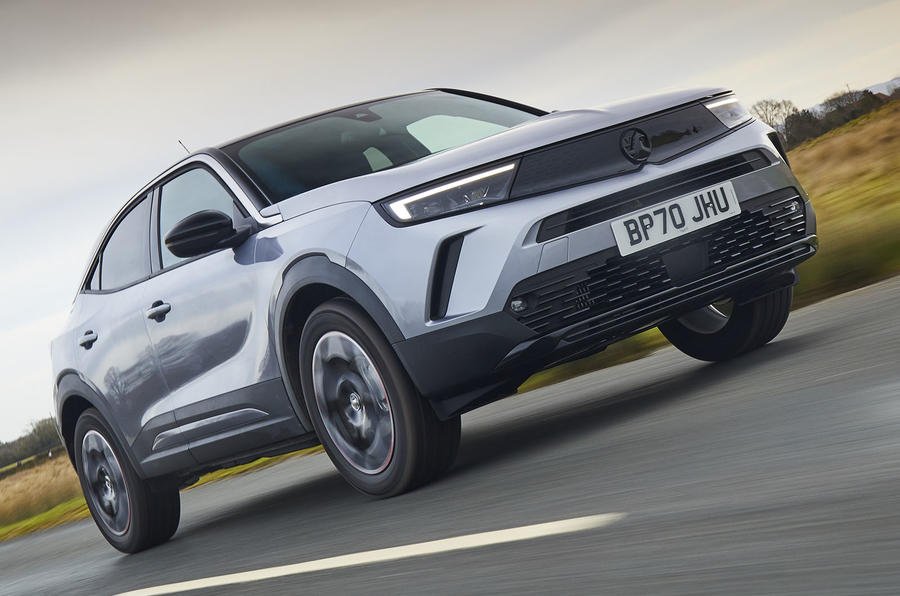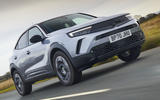What is it?
This isn’t the first time we’ve heard that the days of the unremarkable Vauxhall are behind us. But if the new Mokka is any indication, that statement may finally be true.
The compact crossover has been reborn for its second generation, dropping the questionable ‘X’ from its model name and adopting radical new styling that promises to eventually influence the British brand’s entire line-up. It will, for the first time, also be sold in pure-electric form.
Such a departure from what came before may seem bold, seeing how popular the first-generation Mokka eventually became with customers. It found more than a million homes across Europe after its introduction in 2012, including more than 200,000 here in the UK. But this is an intensely competitive corner of the market, with rivals that are increasingly style- and technology-led. Bold is exactly what was called for.
Much of the Mokka’s looks are carried over wholesale from the 2018 GTX concept car, including the new, minimal front grille Vauxhall calls the Vizor. It’s this fully sealed panel, which scoops up the headlights and simplified griffin badge into one element, that you can expect to see on future models. It’s also functional, helping direct air around the car and reducing the drag coefficient from 0.35 of the old model down to 0.32 here.
Style is subjective, of course, and the contrasting roofline accents won’t be to all tastes, but there’s no question the new Mokka stands out in a way the old one never did, and can arguably now rival the likes of Ford’s Ford Puma for head-turning ability.
Underneath, the Mokka is the latest model to be built on the PSA Group’s common modular platform (CMP), joining the Peugeot 2008, DS 3 Crossback and Citroën C4, as well as Vauxhall’s own Vauxhall Corsa supermini. These new underpinnings have helped reduce weight by as much as 120kg compared with the outgoing car, while steel construction has increased body rigidity by 15% on ICE models (and as much as 30% on the Mokka-e). It sits some 124mm shorter than the outgoing car, but 10mm wider and with a 2mm longer wheelbase. Significantly shorter front and rear overhangs help give the car a more dynamic stance, without compromising on interior space.
Powertrain options are shared with the Corsa, meaning a choice of two petrol and one diesel engine, as well as the pure-electric variant. The 1.2-litre three-cylinder turbocharged petrol is available in 99bhp and 128bhp outputs, but only the latter can be combined with an eight-speed automatic transmission. The entry-level petrol and 1.5-litre 108bhp diesel are restricted to a six-speed manual gearbox.
The range begins with entry-level SE trim, which includes 16in alloy wheels, LED lights, automatic emergency braking and forward collision alert, while the step-up Elite Nav sits on 17in wheels and gains rear parking sensors, a reversing camera and Vauxhall Connect online services. Vauxhall’s sporty SRI trim also makes an appearance on a Mokka for the first time, adding 18in alloy wheels, black exterior elements, sports seats and tinted rear windows. Range-topping Ultimate Nav trim is exclusive to ICE-powered cars, and includes keyless entry, wireless smartphone charging and matrix LED headlights. All cars get forward collision alert, cruise control with limiter, and speed limit recognition as standard.































































Join the debate
Add your comment
Agree this is a stylish & classy car, both inside and out. I get FastRenaultFan's point about the front of this SRI model, however. The black styling pack looks good, though would have retained the chrome Griffin logo as a focal point. Various commentators have compared the chrome-logo 'visor' to the 70s Manta; this blacked-out version reminds me more of the 60s Viva GT.
This one looks very classy especially that interior. I do think they could have been braver at the front as it is very boring but otherwise it is a classy car. The side and the rear are classy and stylish do.
This one looks very classy especially that interior. I do think they could have been braver at the front as it is very boring but otherwise it is a classy car. The side and the rear are classy and stylish do.